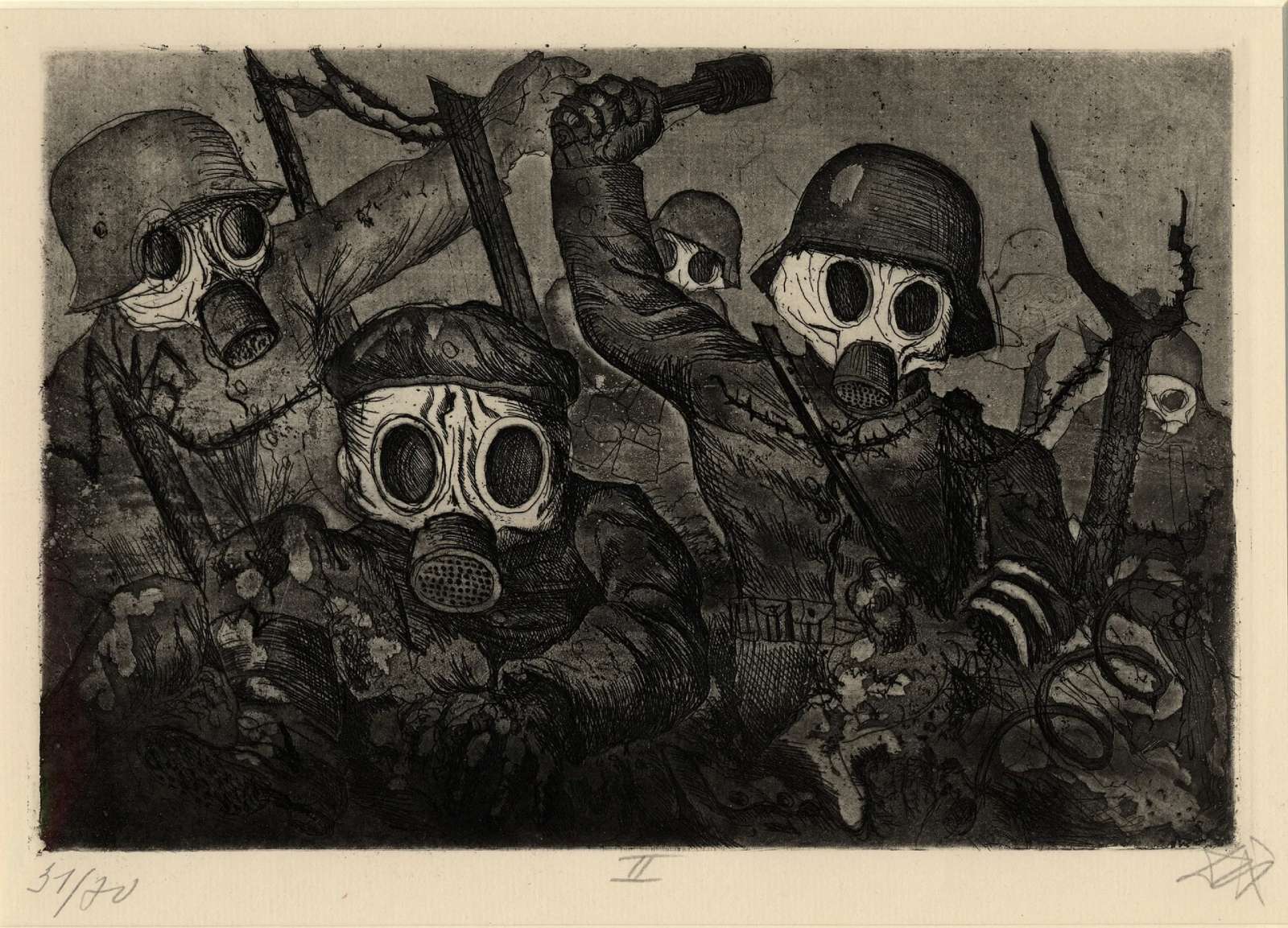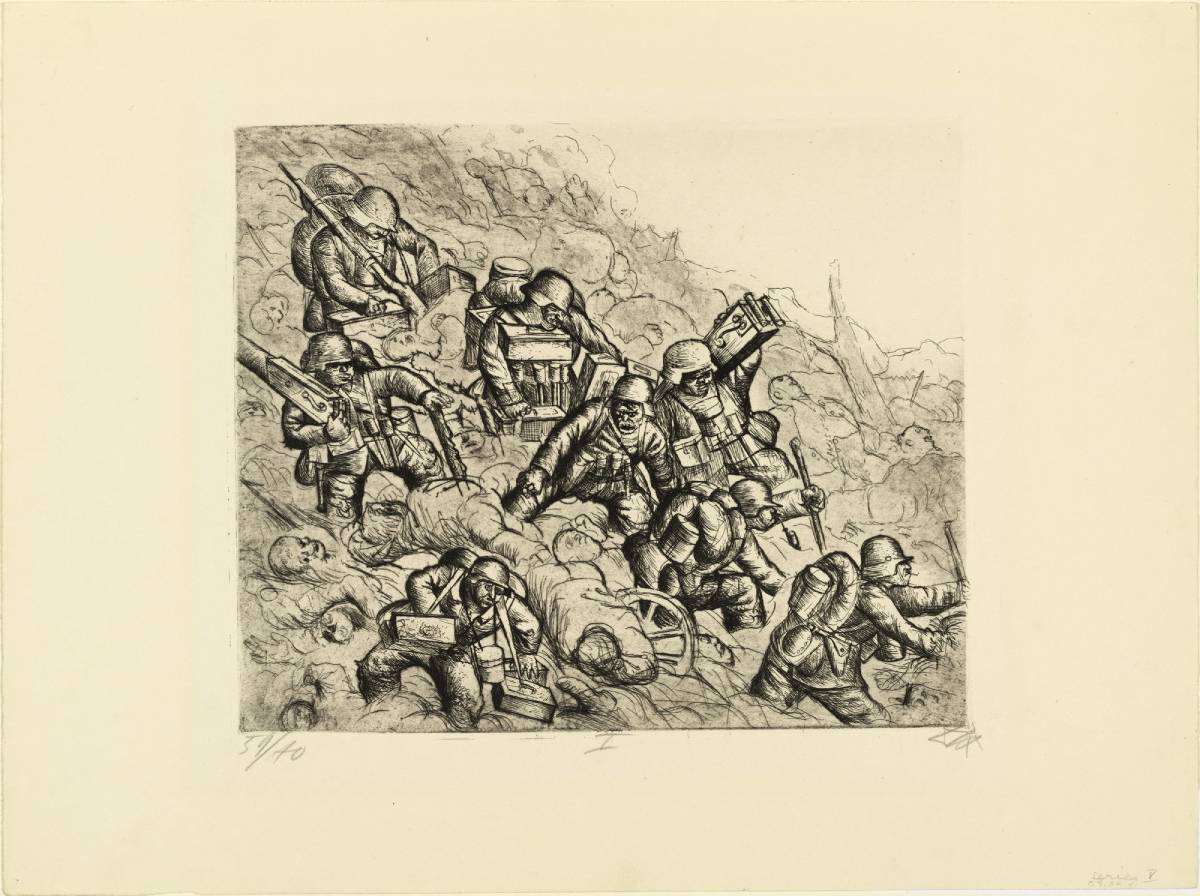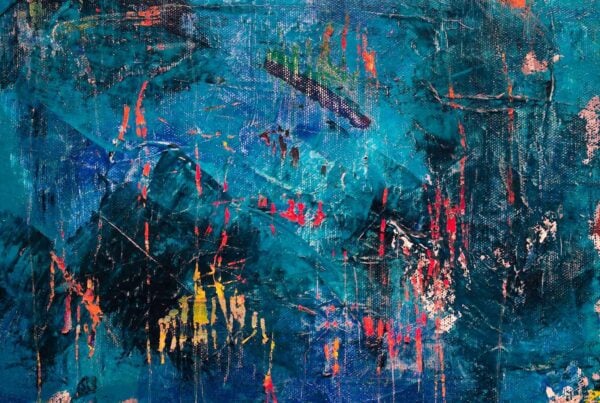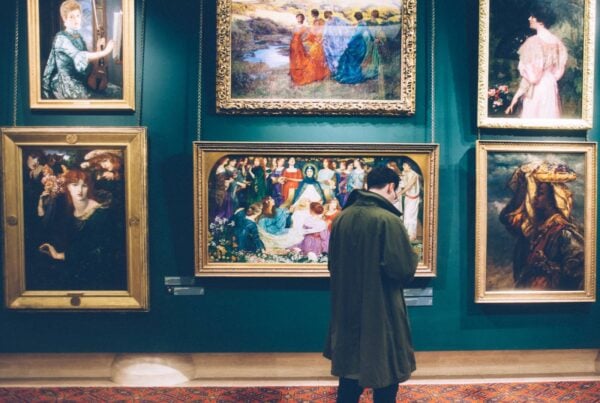Otto Dix, a German painter and printmaker, is perhaps best known for his brutally honest portrayal of war and its devastating impact. His series of etchings, Der Krieg (The War), captures the sheer horror and inhumanity of conflict, with a rawness that few others have ever approached. Created in 1924, Der Krieg is a chilling response to the trauma of World War I, which Dix himself experienced first-hand as a soldier. It was through this body of work that Dix attempted to bring the brutal realities of war to a public that was often fed romanticised or sanitised visions of the battlefield.
The collection is composed of fifty etchings that focus on various aspects of war—the devastation of landscapes, the agony of the soldiers, and the silent suffering of civilians. Dix’s intention was to reveal the darker side of humanity, using imagery that is both graphic and deeply emotional. This series was his testimony, not just of his own experiences, but also of the collective trauma that had spread across Europe.
In this article, we explore the story behind Der Krieg, examine a few of the notable etchings from this collection, and understand how Dix used his art to reveal the harrowing truths of warfare, creating an indelible impression on all who view his work.
Table of Contents
The Background of Der Krieg
Otto Dix enlisted in the German army in 1914, experiencing the horrors of trench warfare on both the Western and Eastern fronts. This exposure left an indelible mark on him. As an artist, Dix was determined to document the visceral experiences he and his comrades endured, but not in a romanticised or patriotic manner. Instead, his works reflect the stark, grotesque, and often surreal aftermath of battlefields. War had stripped away the humanity of those involved, reducing the landscape to a grim theatre of suffering.
Dix created Der Krieg as a series of fifty etchings, inspired by Francisco Goya’s The Disasters of War. Just as Goya’s work served as a timeless indictment of violence, Dix’s etchings are a relentless depiction of the scars left by World War I on both soldiers and civilians. He wanted to make sure that the public did not forget the reality of war, especially at a time when there were attempts to glorify the sacrifice of soldiers or overlook the hardships faced by those who survived.
The etchings are notable not only for their technical brilliance but also for the way Dix uses the medium to convey texture and tone—capturing the harshness of the war-torn environment with remarkable detail. The intricate lines convey the disarray of the trenches, the twisted metal of wreckage, and the fragile, broken bodies left in their wake. His use of shadow and light creates a chilling atmosphere, highlighting the contrast between the living and the dead, between hope and utter despair.
A Few of Otto Dix’s Notable Etchings
Below, we examine a few particularly impactful etchings from the Der Krieg series, highlighting how Dix used his skill to illustrate the trauma of war:
‘Dead Sentry in the Trenches (Flanders)’
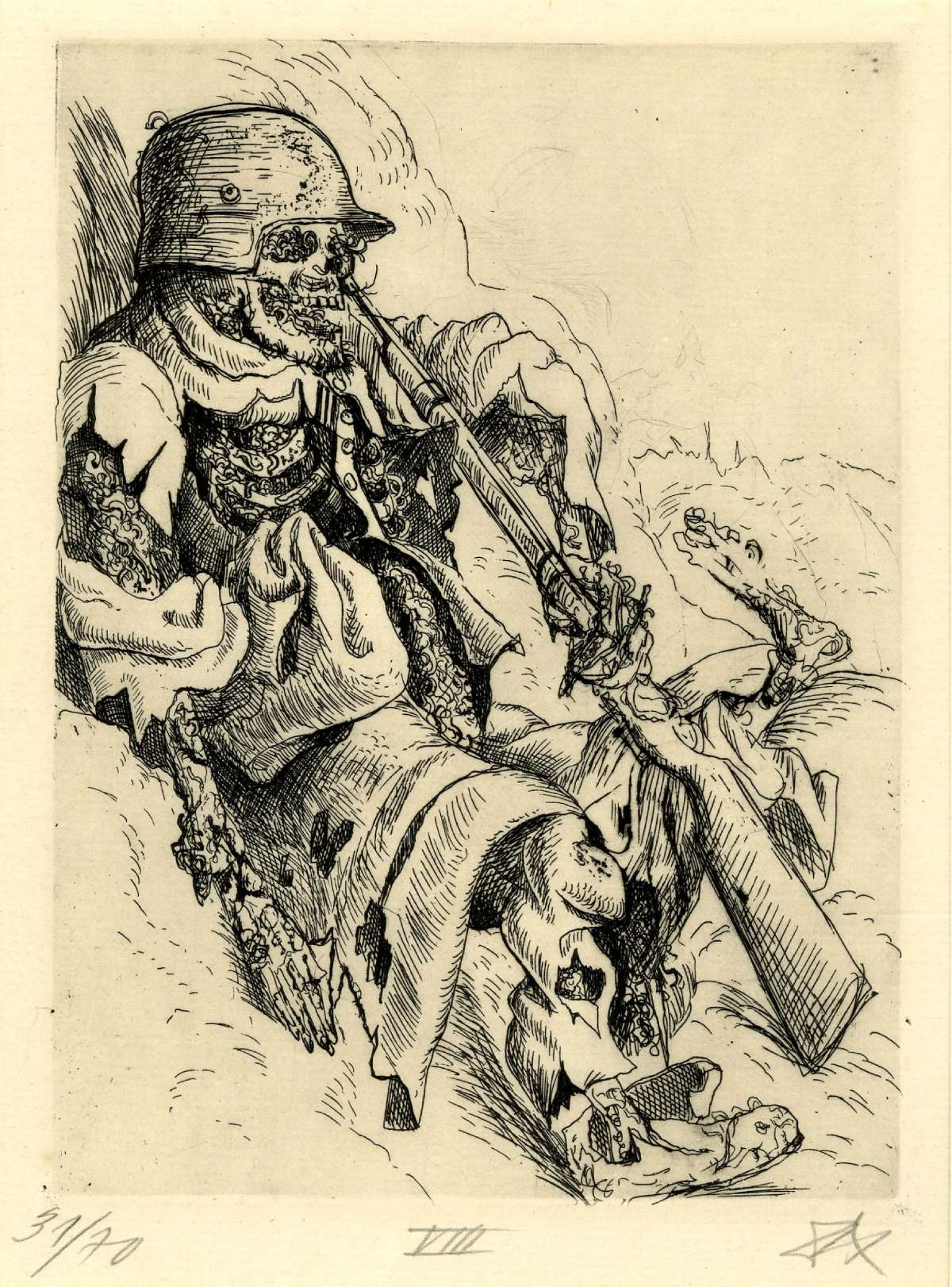
Otto Dix – Dead Sentry in The Trenches 1924
In Dead Sentry in the Trenches (Flanders), Dix presents a horrifying yet starkly realistic view of a decomposing soldier. The sentry, left abandoned in a collapsed trench, lies half-buried, his body in an advanced state of decay.
- Visual Impact: The intricate etching lines convey the texture of the sentry’s uniform, merging seamlessly with the rotting flesh and mud that envelops him. Every detail is painstakingly rendered—the sagging eye sockets, the torn fabric, and the chaotic mix of earth and human remains.
- Symbolism: Dix portrays the soldier almost as part of the earth itself, illustrating how men were literally consumed by the war, their individuality lost amidst the dirt and destruction. The composition is claustrophobic, reflecting the suffocating atmosphere of trench warfare. This integration of the human form with the environment reinforces the idea that war strips away personal identity, leaving behind only the remnants of what was once a living person.
‘Wounded Man (Autumn 1916, Bapaume)’
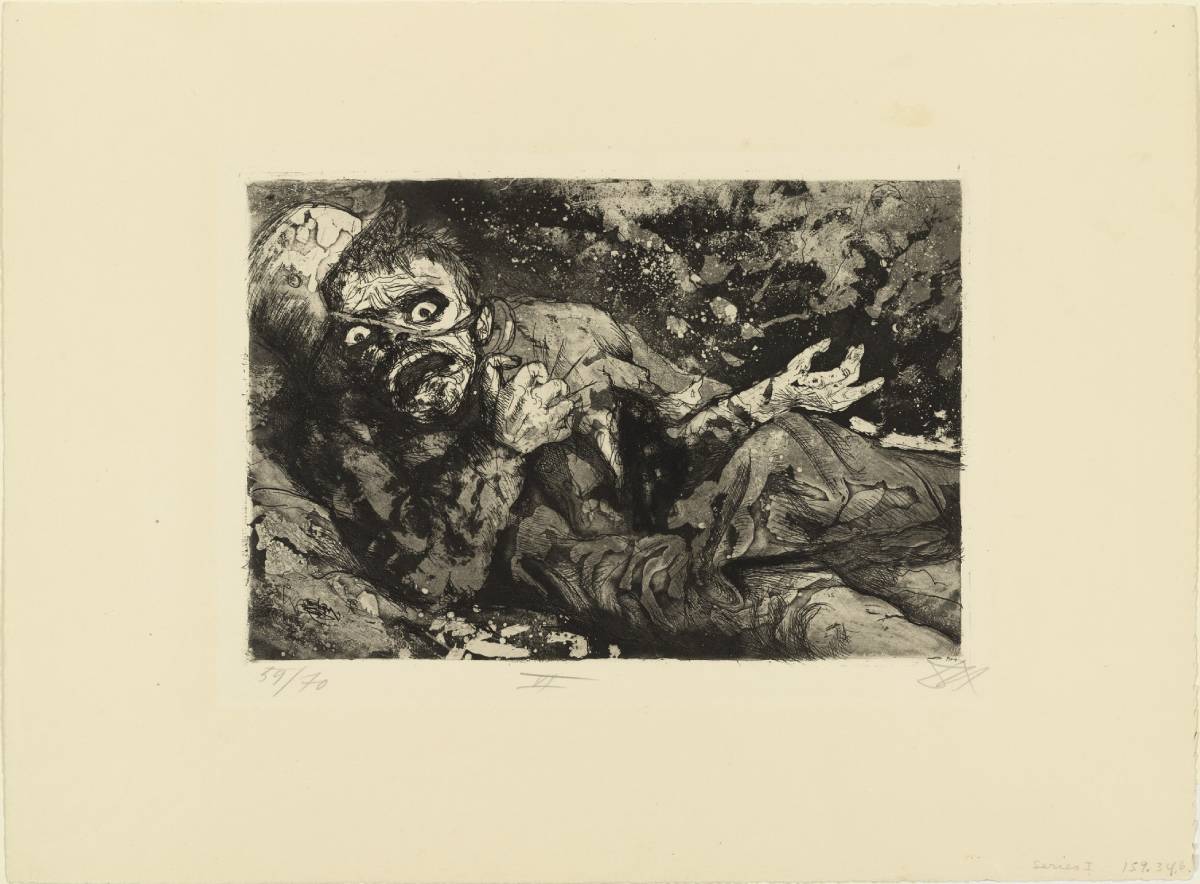
Otto Dix – Wounded Man (Autumn 1916, Bapaume) 1924
In Wounded Man (Autumn 1916, Bapaume), we see a soldier barely standing, his face twisted in pain. His body appears skeletal, almost grotesque, as if the war has stripped away his humanity.
- Emotion and Detail: Dix’s use of cross-hatching in this piece adds an intense sense of movement and chaos, reflecting both the physical pain and the mental turmoil of the soldier. The etched lines seem to vibrate, giving the impression of trauma that never ceases. The eyes of the soldier stare blankly, devoid of hope or recognition, reflecting the empty shell that remains after relentless suffering.
- Context: This etching serves as a reminder of the ongoing suffering of soldiers long after the guns had gone silent. Dix’s empathy for his fellow soldiers is clear, yet he does not shy away from depicting their agony. The skeletal form is a testament to the harsh physical toll exacted by the war—a toll that leaves soldiers broken in both body and spirit. It is a commentary on the way war strips individuals to their bare essence, leaving only the struggle for survival.
‘Stormtroops Advancing Under a Gas Attack’
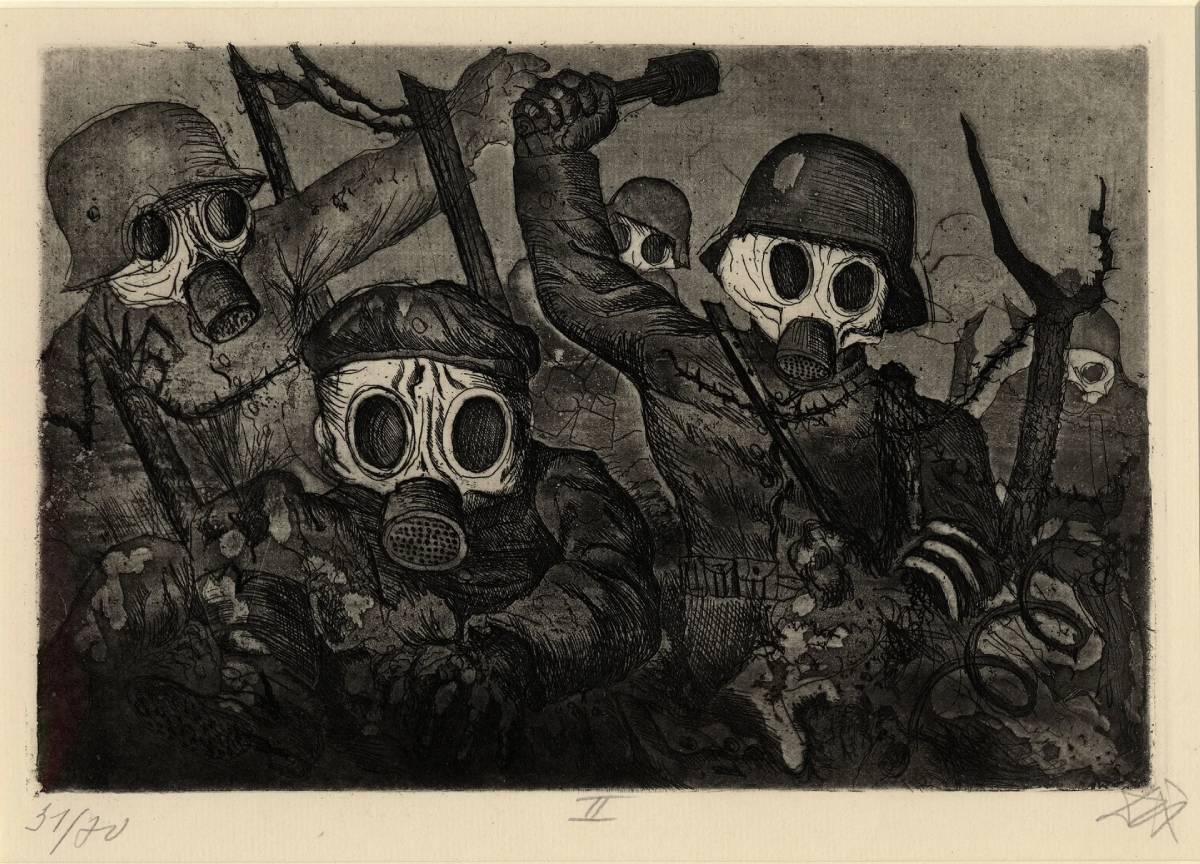
Otto Dix – Stormtroops Advancing Under a Gas Attack 1924
Stormtroops Advancing Under a Gas Attack (Sturmtruppe geht unter Gas vor) is another striking etching from the series, depicting German soldiers advancing through a toxic fog, their faces obscured by gas masks.
- Chilling Imagery: The gas masks give the soldiers a dehumanised, insect-like appearance, turning them into faceless agents of destruction. The thick lines and heavy cross-hatching create a sense of disorientation, as if the soldiers are moving through a nightmare. The toxic fog envelops everything, blurring the line between man and machine.
- Symbolic Meaning: This etching represents the terrifying advancements in warfare technology, where even the air itself becomes a weapon. The soldiers, with their mechanical appearance, reflect the loss of humanity and the way modern warfare turned individuals into mere cogs in a vast war machine. Dix captures the helplessness and inevitability of their advance, as they move forward into a landscape devoid of hope or life.
The Emotional and Artistic Complexity of Der Krieg
Otto Dix’s Der Krieg is not just a historical record; it is an emotional exploration of the consequences of war, with each etching evoking a different aspect of the horror and suffering that Dix witnessed. Unlike the propagandist imagery that often glorified military service, Dix stripped war of any glamour or heroism, exposing its true nature as a dehumanising and senseless ordeal. The detailed etching technique allowed him to capture every unsettling nuance—from the grotesque disfigurement of bodies to the hollow, haunted expressions of those who survived.
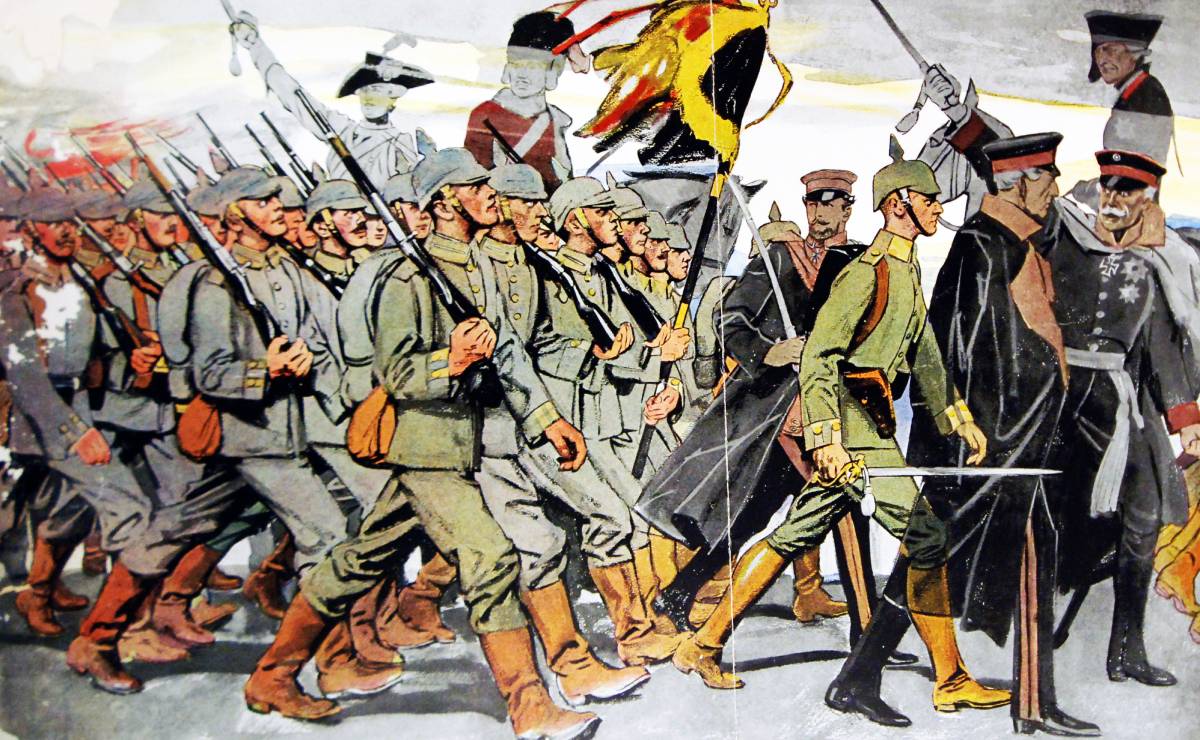
WWI-Central Powers-German Illustrated Magazine Article – Source Wikipedia
The series also reflects the disillusionment that followed the war. In Dix’s Germany, there was a strong sense of betrayal felt by many soldiers, who returned home to find that the sacrifices they had made were in vain. Dix’s work communicates this disillusionment, depicting both the battlefield and the home front as places scarred by the consequences of conflict. The stark realism and almost surreal presentation of trauma reveal Dix’s desire to confront viewers with the darker aspects of human nature—those aspects that surface during times of extreme crisis.
Der Krieg and Its Relevance Today
The impact of Dix’s work goes beyond his own time. The etchings in Der Krieg serve as a grim reminder of the human cost of war, applicable to conflicts throughout history and into the modern day. In an age where war is often sanitised by the media, Dix’s raw, unfiltered vision reminds us of the stark realities that lie beneath the surface. His work challenges the often dispassionate reports of casualties and damage by focusing on the very human, individual aspects of suffering—something that has, sadly, remained consistent throughout the decades.
The imagery of Der Krieg remains deeply relevant, especially in light of modern conflicts where civilian suffering and the destruction of homes, landscapes, and lives continue unabated. Dix’s work reminds us that behind every statistic is a person—a life torn apart by forces beyond their control. This perspective is vital for maintaining our humanity, especially when faced with reports of far-off conflicts that can often feel abstract or impersonal.
Conclusion
Otto Dix’s Der Krieg remains an unforgettable visual record of World War I, revealing the immense suffering of those caught in the conflict. Through powerful etchings like Dead Sentry in the Trenches, Wounded Man, and No Man’s Land, Dix compels the viewer to confront the horrific truth of war, without embellishment or omission. His portrayal of war is direct and unyielding, forcing us to see beyond the glorified stories of heroism and to acknowledge the pain, loss, and senselessness that accompany armed conflict.
His work speaks across generations, challenging us to remember the past and question the romanticisation of warfare. By examining Dix’s art, we are reminded that the true cost of war is immeasurable, resonating far beyond the battlefield. Dix’s haunting imagery serves as a stark warning, encouraging us to never forget the lives that were lost and the scars that were left behind. In an age of increasingly sophisticated and distant forms of warfare, his message remains vital: war is never without cost, and its legacy is carried not just by nations, but by each individual who endures its horrors.
Sources & Other Articles
- https://www.theguardian.com/artanddesign/2014/may/14/first-world-war-german-art-otto-dix
- https://www.moma.org/collection/works/63259
- https://gerryco23.wordpress.com/2014/08/18/otto-dixs-war-unflinching-and-disturbing-but-dedicated-to-truth/
- https://www.smithsonianmag.com/history/legends-what-actually-lived-no-mans-land-between-world-war-i-trenches-180952513/
- https://www.moma.org/s/ge/collection_ge/objbyppib/objbyppib_ppib-12_sov_page-37.html
- https://www.theguardian.com/artanddesign/gallery/2014/may/14/art-apocalypse-otto-dix-first-world-war-der-krieg-in-pictures




